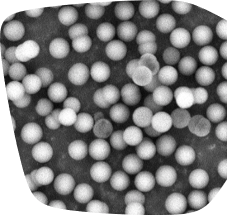Supel™ Carbon LC U/HPLC Columns
Porous graphitic carbon (PGC) particles, designed by a unique and patented synthetic process, constitute the packing of Supel™ Carbon LC U/HPLC columns. The key advantages of using PGC columns over silica particle-packed columns include:
- Elevated Temperature Stability: Columns can be readily operated at temperatures up to 250 °C, thereby allowing faster and more efficient separations.
- pH Stability: Compatible with mobile phases in the pH range of 1 – 14 at any temperature without causing a decline in the column lifespan.
- Unique Retention Mechanism: The Polar Retention Effect on Graphite (PREG) mechanism allows for the retention of polar or charged compounds without hydrophilic interaction liquid chromatography (HILIC) conditions. The mechanism also allows the resolution of geometric isomers.
- Compatibility with Any Solvent: Any polar or non-polar solvent can be used for the resolution of an analyte of interest.
- Pressure Stability up to 700 bar.
Supel™ Carbon LC Specifications | |
|---|---|
| Particle Platform | Porous Graphitic Carbon (PGC) |
| Particle Size | 2.7 µM |
| Pore Size | 200 Å |
| Surface Area | 155 m2/g |
| pH Range | 1-14 |
| Maximum Temperature | 250 °C |
The Supel™ Carbon LC columns are available in internal diameters of 2.1, 3.0, and 4.6 mm with guard cartridges and holders available for each inner diameter.

Figure 1. Scanning electron microscope (SEM) image of the Supel™ Carbon LC particles. Notice the narrow particle size distribution
The patented synthetic process used for the synthesis of Supel™ Carbon LC columns generates a narrow particle size distribution (PSD). The resulting narrow PSD leads to a higher efficiency due to the reduction in brand broadening caused by eddy diffusion effects.
One application demonstrating the Supel™ Carbon LC’s excellent resolving power is the separation of Vitamins D2 and D3 metabolites. These metabolites are polar and structurally similar, making their chromatographic separation difficult on the conventional silica based reversed-phase columns. The Supel™ Carbon LC column resolves the metabolites with high efficiency.
Resolution of Vitamin D2 and D3 Metabolites on Supel™ Carbon LC Column
![Chromatographic separation of Vitamin D2 and D3 metabolites on Supel™ Carbon LC. Conditions: Column: Supel™ Carbon LC, 10 cm x 2.1 mm I.D., 2.7 µM; Mobile Phase: [A] 2-Propanol; [B] Tetrahydrofuran; Gradient: 0% B to 70% B in 15 min; hold at 70% B for 5 min; Flow Rate: 0.3 mL/min; Column Temp.: 25 °C; Detector: UV, 275 nm; Injection: 2.0 µL; Sample: Vitamin D2 and D3 metabolites mix, varied concentration, ethanol Chromatographic separation of Vitamin D2 and D3 metabolites on Supel™ Carbon LC. Conditions](/deepweb/assets/sigmaaldrich/marketing/global/images/technical-documents/articles/analytical-chemistry/small-molecule-hplc/chromatographic-graph/chromatographic-graph.png)
Figure 2.Chromatographic separation of Vitamin D2 and D3 metabolites on Supel™ Carbon LC. Conditions: Column: Supel™ Carbon LC, 10 cm x 2.1 mm I.D., 2.7 µM; Mobile Phase: [A] 2-Propanol; [B] Tetrahydrofuran; Gradient: 0% B to 70% B in 15 min; hold at 70% B for 5 min; Flow Rate: 0.3 mL/min; Column Temp.: 25 °C; Detector: UV, 275 nm; Injection: 2.0 µL; Sample: Vitamin D2 and D3 metabolites mix, varied concentration, ethanol
| Peaks | Compound | Retention Time (min) |
|---|---|---|
| 1 | 3-epi-25-hydroxyvitamin D3 (50 µg/mL) | 8.294 |
| 2 | 25-hydroxyvitamin D3 (25 µg/mL) | 9.125 |
| 3 | 3-epi-25-hydroxyvitamin D2 (50 µg/mL) | 11.126 |
| 4 | 25-hydroxyvitamin D2 (100 µg/mL) | 12.052 |
Supel™ Carbon LC columns are compatible with all HPLC, UHPLC, UPLC, and LC-MS instruments.
Related Product Resources
Application note: LC-MS/MS Analysis of 20 Underivatized Amino Acids on Supel™ Carbon LC Column
Application note: UHPLC-MS/MS Analysis of Polar Pesticides on the Supel™ Carbon LC Column
Application note: UHPLC Analysis of Vitamin D2 & D3 Metabolites and Epimers on Supel™ Carbon LC Column
To continue reading please sign in or create an account.
Don't Have An Account?